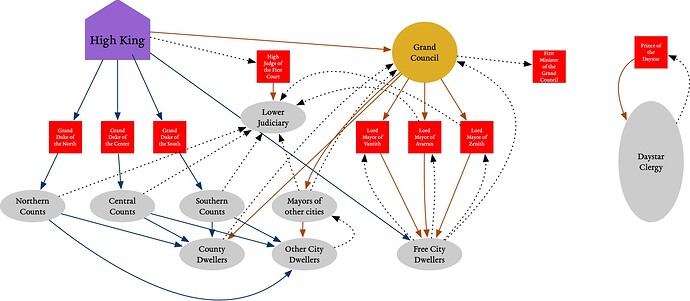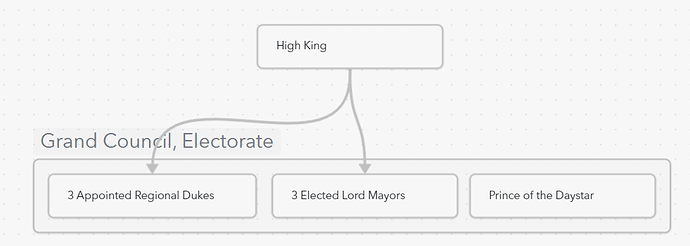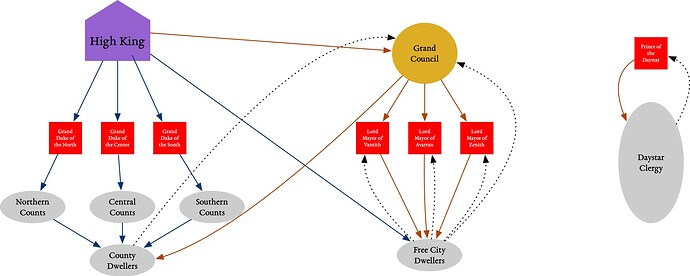Arvel is a prosperous late feudal society. This thread is to discuss its political structure.
At the base of the political structure are the Arvan peoples. These can be divided into two categories based on the kind of basic polity they inhabit. City dwellers live in cities. County dwellers live in small towns, villages, farms, estates, or other locations in the countryside.
Ruling over them are two political hierarchies: the nobility, who are in charge of security (including both war and policing), and the civil administration, which takes responsibility for law-making, judicial duties, regulation of trade, tax policy, and the like.
The nobility have a simpler structure. The realm is divided into small fiefs known as counties, each of which is ruled by a count or countess. Each count/countess has a seat in a castle, and is responsible for security within their county. This includes the following: maintaining an arsenal where weapons of war are stored, maintained, and distributed to the levies when they are mobilized; training the folk of the county in martial disciplines, which includes ensuring that the county levies can provide their allotment of pikemen, archers, and light cavalry; maintaining a retinue of knights and professional soldiers who serve as a police force in peacetime and are housed in the castle; enforcing the civil law, which includes appointing a county judge who makes up the first line of the judicial system and hears both civil and criminal cases; lately, they collect the taxes.
Most cities fall within the security jurisdiction of a single count/countess. The duties of the count/countess as regards the cities are a bit different. Cities have a mayor and a town watch to manage their civil law. Mayors are chosen by the citizens of the city in elections held every third year. The mayor’s government collects taxes and the town watch handles policing. The mayor appoints a city judge (or more, in larger cities). However, the local count or countess does train the city dwellers for war, keeps weapons for them in their arsenal, and leads the city levies if called.
Above the counts/countesses are three dukes. The Duke of the North, The Duke of the Center, and the Duke of the South. Like counts, the Dukes maintain a castle. Ducal arsenals hold more substantial weaponry, such as the parts needed to quickly assemble rams, artillery, and other siege equipment. Ducal retinues are large and form the nation’s first response force in case of a surprise invasion. Dukes receive a portion of the tax from the counties and cities under their protection and serve as prominent councillors to the crown. The Dukes each also appoint an appellate judiciary, to which decisions made by the ground level judges may be taken by parties unhappy with the outcome.
Above the three Dukes is the High King. The High King has ultimate security responsibility, and reigns from the royal seat in Zenith. A royal arsenal of magical and high value weapons sits somewhere in the city (location undisclosed for security reasons), and the Crown Retinue is a small army unto itself. The High King appoints First Judge of the High Court. the High Court has the final say on legal matters, and the lesser judges are selected by the First Judge.
The High King is an elected monarch. The constitution lays out nine electoral offices. Each of the three Dukes is an elector. In addition, the First Judge is an elector. The Prince of the Daystar, who leads the Church of the Daystar, is an elector but does not answer to either the nobility or the civil administration.
The other four electors come from the civil administration. The next one is the First Minister of the Grand Council. The Grand Council is Arvel’s legislative body, with responsibility for setting domestic policy, especially tax and trade regulation. Every mayor is a member of the Grand Council, and every county elects itself a delegate to the council as well.
This brings us to the final three electoral offices, and the most anomalous type of polity in Arvel. The last three electors are the Lord Mayors of the Free Cities: Zenith, Vantith, and Avarran. The Free Cities are grand metropolises with hundreds of thousands of inhabitants each. Internally they function like other cities, ruled by a Lord Mayor who is elected every third year. But their security falls to the High King directly. The lesser nobility have no authority in the Free Cities, and they send a delegation proportionate to their population to the Grand Council.
To summarize all this, I have included a graph, which should be read as follows:
- Circles and ovals represent groups of people
- Red squares represent electoral offices
- The High King has their own purple shape
- Dotted arrows show who elects/appoints whom
- Blue arrows show who has security responsibility for whom
- Brown arrows show who has civil administration over whom
- Height in the graph roughly corresponds to the power an individual/group wields


